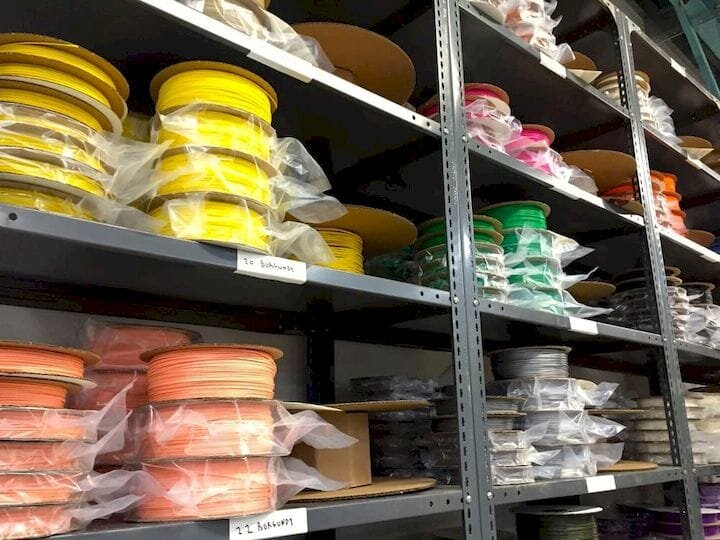![Warehoused stocks of 3D printer filament [Source: Fabbaloo]](https://fabbaloo.com/wp-content/uploads/2020/05/image-asset_img_5eb090829820d.jpg) Warehoused stocks of 3D printer filament [Source: Fabbaloo]
Warehoused stocks of 3D printer filament [Source: Fabbaloo]
I believe there’s been a significant shift in how 3D printer filament is bought these days.
I’ve been involved in shopping for 3D printer filament for many years, starting so long ago that I actually considered buying “ABS Welding Wire” for use in the primitive desktop units I operated at the time.
“Operated” is perhaps a generous term; “Maintained and Repaired” is a more appropriate descriptor.
3D Printing Filament History
In any case, filament was very hard to find in those days. There were essentially no local providers; no one knew what you were talking about. The only sources seemed to be far-away online vendors offering a smattering of materials in undesirable colors.
You were lucky to get anything. And that’s what people used: anything.
Many parties entered the 3D printer filament market: entrepreneurial resellers, local plastics manufacturers and others. Few had any real understanding of the actual needs of the market.
Indeed, the market was very hard to pin down: many machines of the day were kits that one would have to assemble by hand. As a result, these systems would tend to have slightly different characteristics from one machine to another, making it challenging for a filament manufacturer to develop a product optimal for a given machine — because they were all different.
3D Printer Filament Standardization
But then things began to standardize with pre-assembled machines becoming the norm. These units had predictable characteristics that filament manufacturers could depend upon. As a result we then started to see filament that seemed to work.
But many DIY 3D printer operators were working on limited funds, and the prospect of paying high prices for an ongoing supply of 3D printer filament was not welcomed. Thus many operators sought cheap 3D printer filaments.
And they found them. Many 3D printer filament suppliers focused on the low-cost factor above all others in an attempt to capture the market. They succeeded, but only for a while.
Cheap Filaments Don’t Work
![A former spool of 3D printer filament that had a bad day [Source: Fabbaloo]](https://fabbaloo.com/wp-content/uploads/2020/05/image-asset_img_5eb09082e9a3d.jpg) A former spool of 3D printer filament that had a bad day [Source: Fabbaloo]
A former spool of 3D printer filament that had a bad day [Source: Fabbaloo]
The reason was that some of these cheap filaments simply didn’t work. They were of such low quality that in many cases they could not be used for even a single successful print. I recall trying one awful composite filament infused with wood fiber. Within five minutes of 3D printing with it, the nozzle was completely jammed with “large” wood fibers. I had to remove the nozzle and blowtorch out the debris to fix it.
And then I blowtorched the wood filament.
The shift to “actually works” filament began around then. Producers began to cite their diameter tolerances, for example, in a bid to ensure clients they were getting usable product.
Increasing Filament Quality
![Prusament 3D printer filament tracks each and every spool’s quality in a database accessible via a QR code [Source: Fabbaloo]](https://fabbaloo.com/wp-content/uploads/2020/05/prusament-qr-codes-1_img_5eb0908339eef.jpg) Prusament 3D printer filament tracks each and every spool’s quality in a database accessible via a QR code [Source: Fabbaloo]
Prusament 3D printer filament tracks each and every spool’s quality in a database accessible via a QR code [Source: Fabbaloo]
Nowadays there seems to be another shift, one to even higher levels of quality.
It seems that the 3D printers of today are even more particular about the materials you put in them, simply because the demands of operators for the highest-quality output is most important. With machines adjusted to high levels of precision, the tolerance for less-than-optimal filaments is not good.
Today we often see discussions of what filament works best more than we see discussions of where the cheapest filament can be found.
3D Printer Filament Buying Strategy
My thought is that we’ll continue to see improvements in filament quality until the industry overall produces product that’s more or less guaranteed to work. Then the market will shift to competitive pricing.
Until then, look for filament that works the best in your machine.

